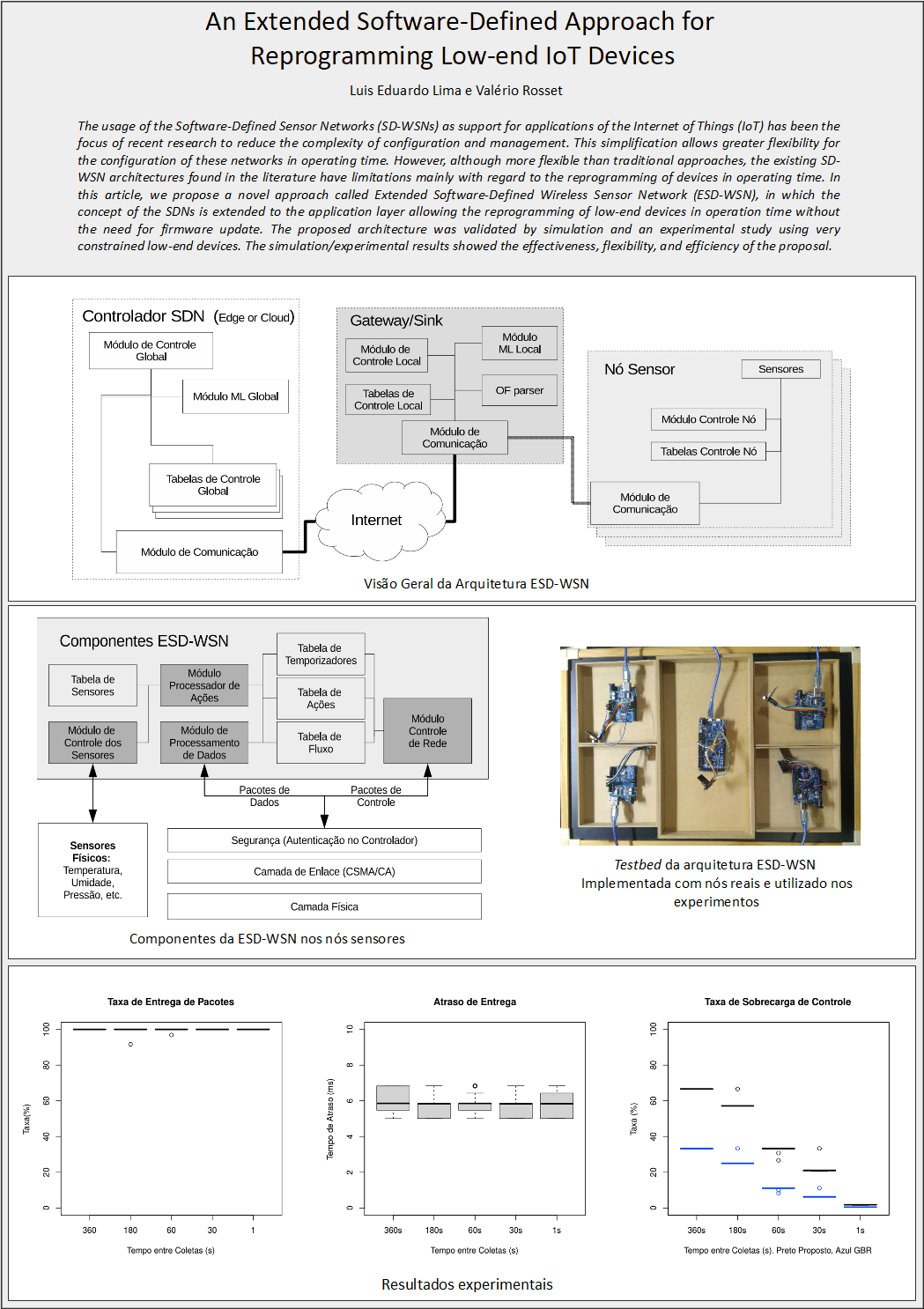An Extended Software-Defined Approach for Reprogramming Low-end IoT Devices
Keywords:
Software-Defined Networks, Network Architecture, Internet of ThingsAbstract
The usage of the Software-Defined Sensor Networks (SD-WSNs) as support for applications of the Internet of Things (IoT) has been the focus of recent research to reduce the complexity of configuration and management. This simplification allows greater flexibility for the configuration of these networks in operating time. However, although more flexible than traditional approaches, the existing SD-WSN architectures found in the literature have limitations mainly with regard to the reprogramming of devices in operating time. In this article, we propose a novel approach called Extended Software-Defined Wireless Sensor Network (ESD-WSN), in which the concept of the SDNs is extended to the application layer allowing the reprogramming of low-end devices in operation time without the need for firmware update. The proposed architecture was validated by simulation and an experimental study using very constrained low-end devices. The simulation/experimental results showed the effectiveness, flexibility, and efficiency of the proposal.
Downloads
References
S. Costanzo, L. Galluccio, G. Morabito, and S. Palazzo, “Software defined wireless networks: Unbridling sdns,” in Software Defined Networking (EWSDN), 2012 European Workshop on, pp. 1–6, IEEE, 2012.
A. Mahmud and R. Rahmani, “Exploitation of openflow in wireless sensor networks,” in Computer Science and Network Technology (ICCSNT), 2011 International Conference on, vol. 1, pp. 594–600, IEEE, 2011
H. I. Kobo, A. M. Abu-Mahfouz, and G. P. Hancke, “A survey on software-defined wireless sensor networks: Challenges and design requirements,” IEEE Access, vol. 5, pp. 1872–1899, 2017.
J. Kipongo, E. Esenegho, and T. G. Swart, “Efficient topology discovery protocol using it-sdn for software-defined wireless sensor network,” Bulletin of Electrical Engineering and Informatics, vol. 11, no. 1, 2022.
B. T. De Oliveira, L. B. Gabriel, and C. B. Margi, “Tinysdn: Enabling multiple controllers for software-defined wireless sensor networks,” IEEE Latin America Transactions, vol. 13, no. 11, pp. 3690–3696, 2015.
L. Galluccio, S. Milardo, G. Morabito, and S. Palazzo, “Sdn-wise: Design, prototyping and experimentation of a stateful sdn solution for wireless sensor networks,” in Computer Communications (INFOCOM), 2015 IEEE Conference on, pp. 513–521, IEEE, 2015.
T. Luo, H.-P. Tan, and T. Q. Quek, “Sensor openflow: Enabling software-defined wireless sensor networks,” IEEE Communications Letters, vol. 16, no. 11, pp. 1896–1899, 2012.
N. McKeown, T. Anderson, H. Balakrishnan, G. Parulkar, L. Peterson, J. Rexford, S. Shenker, and J. Turner, “Openflow: enabling innovation in campus networks,” ACM SIGCOMM computer communication review, vol. 38, no. 2, pp. 69–74, 2008.
L. E. Lima, B. Y. L. Kimura, and V. Rosset, “Experimental environments for the internet of things: A review,” IEEE Sensors Journal, vol. 19, no. 9, pp. 3203–3211, 2019.
E. Baccelli, J. Doerr, S. Kikuchi, F. A. Padilla, K. Schleiser, and I. Thomas, “Scripting over-the-air: Towards containers on low-end devices in the internet of things,” in 2018 IEEE International Conference
on Pervasive Computing and Communications Workshops (PerCom Workshops), pp. 504–507, IEEE, 2018.
M. O. Ojo, S. Giordano, G. Procissi, and I. N. Seitanidis, “A review of low-end, middle-end, and high-end iot devices,” IEEE Access, vol. 6, pp. 70528–70554, 2018.
A.-C. Anadiotis, L. Galluccio, S. Milardo, G. Morabito, and S. Palazzo, “Sd-wise: A software-defined wireless sensor network,” Computer Networks, vol. 159, pp. 84 – 95, 2019.
R. C. Alves, D. A. Oliveira, G. Nez, and C. B. Margi, “It-sdn: Improved architecture for sdwsn,” in XXXV Brazilian Symposium on Computer Networks and Distributed Systems, 2017.
G. Bianchi, M. Bonola, A. Capone, and C. Cascone, “Openstate: Programming platform-independent stateful openflow applications inside the switch,” SIGCOMM Comput. Commun. Rev., vol. 44, pp. 44–51, Apr. 2014.
A. Varga, “Discrete event simulation system,” in Proc. of the European Simulation Multiconference (ESM’2001), pp. 1–7, 2001.
J. Hill, R. Szewczyk, A. Woo, S. Hollar, D. Culler, and K. Pister, “System architecture directions for networked sensors,” ACM Sigplan notices, vol. 35, no. 11, pp. 93–104, 2000.
I. Memsic, “Telosb,” in Telosb Mote Platform datasheet, 2022.
F. Osterlind, A. Dunkels, J. Eriksson, N. Finne, and T. Voigt, “Crosslevel sensor network simulation with cooja,” in Local computer networks, proceedings 2006 31st IEEE conference on, pp. 641–648, IEEE,
A. Dunkels, B. Gronvall, and T. Voigt, “Contiki - a lightweight and flexible operating system for tiny networked sensors,” in Local Computer Networks, 2004. 29th Annual IEEE International Conference on,
pp. 455–462, IEEE, 2004.
T. Instruments, “Simplelink sensortag,” in https://www.ti.com/tool/TIDCCC2650STK-SENSORTAG, 2022.
C. B. Margi, R. C. A. Alves, and J. Sepulveda, “Sensing as a service: Secure wireless sensor network infrastructure sharing for the internet of things,” Open Journal of Internet Of Things (OJIOT), vol. 3, no. 1, pp. 91–102, 2017. Special Issue: Proceedings of the International Workshop on Very Large Internet of Things (VLIoT 2017) in conjunction with the VLDB 2017 Conference in Munich, Germany.
A. AG, “Arduino,” in https://www.arduino.cc, 2022.
F. Restuccia, S. D’Oro, and T. Melodia, “Securing the internet of things in the age of machine learning and software-defined networking,” IEEE Internet of Things Journal, vol. 5, no. 6, pp. 4829–4842, 2018.
T. Theodorou and L. Mamatas, “Software defined topology control strategies for the internet of things,” in 2017 IEEE Conference on Network Function Virtualization and Software Defined Networks (NFVSDN), pp. 236–241, 2017.
C. Schurgers and M. B. Srivastava, “Energy efficient routing in wireless sensor networks,” in 2001 MILCOM Proceedings Communications for Network-Centric Operations: Creating the Information Force (Cat. No.01CH37277), vol. 1, pp. 357–361 vol.1, Oct 2001.
A. Boulis, Castalia, A simulator for Wireless Sensor Networks and Body Area Networks. User’s Manual. NICTA, version 3.2 ed., 2011.
S. Nordic, “nrf24 series,” in https://www.nordicsemi.com/Products/nRF24-series, 2022.
T. Sayjari, R. M. Silveira, and C. B. Margi, “Control and data traffic isolation in sdwsn using ieee 802.15. 4e tsch,” in 2021 IEEE Statistical Signal Processing Workshop (SSP), pp. 126–130, IEEE, 2021


